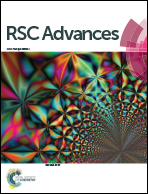Incorporation of silica particles into decellularized tissue biomaterial and its effect on macrophage activation†
Abstract
This paper describes an optimized procedure to incorporate silica particles by hydrolysis/polycondensation of sodium silicate into pericardial (ECM) matrix scaffolds and elucidates the effect of the biocomposites on the in vitro response of macrophages by assessment of the secretion of signaling molecules. Variables (concentration, pH, time) of the sol–gel process allow a gradual incorporation of silica into the ECM scaffolds as confirmed by gravimetry, FT-IR, SEM and EDX microanalysis. The SiO2 incorporation increases the resistance to in vitro degradation but does not alter either the denaturation temperature or content of free amines of non-crosslinked ECM fibrous scaffolds, however, the properties of oligourethane-crosslinked scaffolds are not modified after silica incorporation. Despite the fact that cell viability is gradually decreased for the ECM materials crosslinked with oligourethane and functionalized with silica, murine RAW264.7 macrophages are able to secrete b-FGF, TGF-β1 and VEGF. Secretion of growth factors by RAW264.7 macrophages after 6 h of culture on scaffolds containing silica was lower but it was sustained for 24 h as compared to cells cultured on silica-free materials. Human peripheral blood macrophages cultured with materials containing silica show a higher production of IL-6, IL-10 or TNF-α than with the silica-free counterparts but in a time-dependent manner from one to four days of culture. Results suggest that stimulation of macrophages is induced by silica particles deposited onto the ECM fibrous network, which represents an opportunity to control the cell response to decellularized tissue-derived biomaterials through strategies intended to stimulate cells via signaling molecules secreted by macrophages.


 Please wait while we load your content...
Please wait while we load your content...